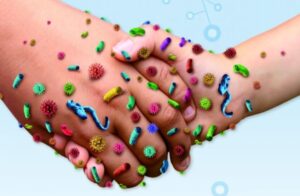Microbes in Human Welfare :-
Microbes are the major components of biological Systems on this earth .
Microbes like bacteria and many fungi can be grown on nutritive media to form colonies , that can be seen with the naked eyes . Such culture are useful in studies on micro-organisms .
Microbes causes disease in animals and plants . All microbes are not harmful , several microbes are useful to man in diverse ways I . e . microbes in human welfare .
Some of the most important contributions of microbes in human welfare –
1 . Microbes in Household products .
2 . Microbes in Industrial Products .
3 . Microbes in Sewage treatment .
4 . Microbes in production of Biogas .
5 . Microbes as Biocontrol agents .
6 . Microbes as Biofertilisers .
Microbes in Household products :-
The production of curd from milk , micro-organisms such as Lactobacillus and other commonly called Lactic acid bacteria grow in milk and convert it to curd . During growth the Lactic acid bacteria produce acids that coagulate and partially digest the milk proteins .
Thus converting milk to curd , which also improve its nutritional quality by increasing vitamin B₁₂ .
- In our stomach too , the Lactic acid bacteria play a very beneficial role in checking disease causing microbes .
- The dough , which is used for making foods such as dosa and idly is also fermented by bacteria . the puffed up appearance of dough is due to the production of CO₂ gas .
- Similarly the dough , which is used for making bread , is fermented using Baker’s yeast .
- A number of traditional drinks and foods are also made by fermentation by the microbes .
- Microbes in human welfare are also used to ferment fish , soyabean and bamboo shoots to make foods .
- Cheese is one of the oldest food items in which microbes were used .

Microbes in Industrial Products :-
Microbes in human welfare are used to synthesise a number of products . Beverages and antibiotics are some examples .
Production on an industrial scale , requires growing microbes in very large vessels called fermentors .
1 . Fermented Beverages :-
Microbes in human welfare , especially yeasts have been used from time immemorial for the production of beverage like wine , beer , whisky , brandy , rum . For this purpose the same yeast Saccharomyces cerevisiae used for bread making and commonly called Brewer’s yeast is used for fermenting malted cereals and fruit juice , to produce ethanol .
- Wine and beer are produced without distillation whereas whisky , brandy and rum are produced by distillation of the fermented broth .
2 . Antibiotics :-
Microbes in Human Welfare as production of Antibiotics .
Antibiotics produced by microbes are regarded as one of the most significant discoveries of the 20th century and have greatly contributed towards the microbes in Human Welfare .
- Antibiotics are chemical substances , which are produced by some microbes and can kill or retard the growth of other (disease causing ) microbes .
- The commonly used antibiotic penicillin . Penicillin was the first antibiotic to be discovered by Alexander Fleming while working on Staphylococci bacteria . Once observed a mould growing in one of his unwashed culture plates around which Staphylococci could not grow . He found out that it was due to a chemical produced by the mould and he named it Penicillin after the mould Penicillium notatum .
After Penicillin other antibiotics were also purified from other microbes .
- Antibiotics have greatly improved our capacity to treat deadly diseases such as plague , whooping cough ( Kali khansi ) , diphtheria ( galghotu ) and leprosy ( kusht rog ) .
3 . Chemicals ,Enzymes and other Bioactive molecules :-
Microbes in human welfare are also used for commercial and industrial production of certain Chemicals like organic acids , alcohols and enzymes .
Examples of acid producers are Aspergillus niger ( a fungus ) of citric acid , Acetobacter aceti ( a bacterium ) of acetic acid , Clostridium butylicum ( a bacterium ) of butyric acid and Lactobacillus ( a bacterium ) of lactic acid .
- Yeast ( Saccharomyces cerevisiae ) is used for commercial production of Ethanol .
- Microbes in human welfare are also used for production of enzymes . Lipases are used in detergent formulations and are helpful in removing oily stains from the laundry .
- Streptokinase produced by the bacterium Streptococcus and modified by genetic engineering is used as a clot buster for removing clots from the blood vessels of patients who have undergone myocardial infection leading to Heart Attack .
- Another bioactive molecules , cyclosporin A , that is used as an immunosuppressive agent in organ transplant patients , is produced by the fungus Trichoderma polysporum .
- Stations produced by the yeast Monascus purpureus have been commercialised as blood cholesterol lowering agents . It acts by competitively inhibiting the enzymes responsible for synthesis of cholesterol .
Microbes in sewage treatment :-
Microbes in human welfare for sewage treatment , we know that large quantities of Waste water are generated every day in cities and towns . A major component of this Waste water is human excreta . This Municipal waste water is also called Sewage . It contains large amounts of organic matter and microbes . Many of which are pathogenic .

Sewage is treated in sewage treatment plants to make it less polluting . Treatment of waste water is done by the heterotrophic microbes naturally present in the Sewage . This treatment is carried out in two stages –
1 . Primary treatment :-
This treatment steps basically involve physical removal of particles ( large and small ) from the Sewage through filtration and sedimentation . These are removed in stages initially , floating debris is removed by sequential filtration . Then the grit ( soil and small pebbles ) are removed by sedimentation . All solids that settle form the primary sludge , and the supernatant forms the effluent . The effluent from the primary settling tank is taken for secondary treatment .
2 . Secondary treatment or biological treatment :-
The primary effluent is passed into large aeration tanks where it is constantly agitated mechanically and air is pumped into it . This allows vigorous growth of useful aerobic microbes into flocs ( masses of bacteria associated with fungal filaments to form mesh like structures ) .
while growing , these microbes consumes the major part of the organic matter in the effluent . This significantly reduces the Biochemical Oxygen Demand ( BOD ) of the effluent .
- BOD refers to the amount of the oxygen that would be consumed if all the organic matter in one litre of water were oxidised by bacteria . The sewage water is treated till the BOD is reduced . The BOD is a measure of the organic matter present in the water . The greater the BOD of Waste water , more is polluting potential .
- Once that BOD of Sewage or waste water is reduced significantly , the effluent is then passed into a settling tank where the bacterial flocs are allowed to Sediment . This Sediment is called activated sludge .
- A small part of the activated sludge is pumped back into the aeration tank to serve as the inoculum . The remaining major part of the sludge is pumped into large tanks called anaerobic sludge digesters . Here , other kinds of bacteria which grow anaerobically , digest the bacteria and the fungi in the sludge . During this digestion , bacteria produce a mixture of gases such as methane , hydrogen sulphide and carbon dioxide . These gases from biogas and can be used as source of energy as it is inflammable .
Microbes in production of Biogas :-
Microbes in human welfare for the production of biogas .
Biogas is a mixture of gases containing predominantly methane produced by the microbial activity and which may be used as fuel .
- Certain bacteria , which grow anaerobically on cellulosic material , produce large amount of methane along with CO₂ and H₂ . These bacteria are collectively called methanogens , and one such common bacterium is Methanobacterium . These bacteria are commonly found in the anaerobic sludge during sewage treatment . These bacteria are also present in the rumen ( a part of stomach ) of cattle .
- A lot of cellulosic material present in the food of cattle is also present in the rumen . In rumen , these bacteria help in The breakdown of cellulose and play an important role in the nutrition of cattle .
Thus , the excreta (dung ) of cattle commonly can gobar , is rich in these bacteria . Dung can be used for generation of biogas , commonly called gobar gas .
Biogas Plant :-

- The biogas plant consists of a concrete tank ( 10 to 15 feet deep ) in which bio- wastes are collected and a slurry of dung is fed .
- A floating cover is placed over the slurry , which keeps on rising as the gas is produced in the tank due to the microbial Activity .
- The biogas plant has an outlet , which is connected to a pipe to supply biogas to nearby houses . The spent slurry is removed through another outlet and may be used as fertiliser .
- Cattle dung is available in large quantities in rural areas where cattle are used for a variety of purposes . So biogas plants are more often built in rural areas . The biogas thus produced is used for cooking and lighting .
Microbes as Biocontrol Agents :-
Microbes in human welfare are also helpful for biocontrol .
Biocontrol refers to the use of biological methods for controlling plant diseases and pests .
Biological control of pests and diseases :-
In agriculture , there is a method of controlling pests that relies on natural predation rather than introduced Chemicals .
The Organic farmer , therefore works to create a system where the insects that are sometimes called pests are not eradicated , but instead are kept at manageable levels by a complex system of checks and balances within a living and vibrant ecosystem . Contrary to the conventional farming practices which often use chemical methods to kill both useful and harmful life form indiscriminately .
- The very familiar Beetle with red and black markings – the Ladybird and Dragonflies are useful to get rid of aphids and mosquitoes respectively .

An example of microbial biocontrol agents that can be introduced in order to control butterfly caterpillars is the bacteria Bacillus thuringiensis ( Often written as Bt ) , These are available in sachets as dried spores which are mixed with water and sprayed onto vulnerable plants such brassicas and fruit trees , where these are eaten by the insect larvae . In the gut of larvae , the toxin is released and the larvae get killed .
- The bacterial disease will kill the Caterpillars , but leave other insects unharmed . Because of the development of methods of genetic engineering in the last decade or so , the scientist have introduced Bacillus thuringiensis toxin genes into plants . Such plants are resistant to attack by insect pests .
- BT-Cotton is one such example , which is being cultivated in some states of our country .
- A biological control being developed for use in the treatment of plant disease is the fungus Trichoderma . Trichoderma species are free living fungi that are very common in the root ecosystems . They are effective biocontrol agents of several plant pathogens .
Microbes as Biofertilisers :-
Microbes in human welfare are use as biofertiliser .The use of the chemical fertilisers to meet the ever – increasing demand of Agricultural produce has contributed significantly to the Environmental pollution . There are problems associated with the overuse of chemical fertilisers and there is a large pressure to switch to organic farming – the use of biofertilisers .
Biofertilisers are organisms that enrich the nutrient quality of the soil .
- The main sources of biofertilisers are bacteria , fungi and cyanobacteria . The nodules on the roots of leguminous plants formed by the symbiotic association of Rhizobium . These bacteria fix atmospheric nitrogen into organic forms , which is used by the plant has nutrient .

- Other bacteria can fix atmospheric nitrogen while free living in the soil ( examples – Azospirillum and Azotobacter ) , thus enriching the nitrogen content of the soil .
- Fungi are also known to form symbiotic associations with plants ( Micorrhiza ) . Many members of genus Glomus form Micorrhiza .
- The fungal symbiont in these associations absorbs Phosphorus from soil and passes it to the plant . Plants having such association show other benefits also , such as resistance to root-borne pathogens , tolerance to salinity and drought , and an overall increase in plant growth and development .
- Cyanobacteria are autotrophic microbes widely distributed in aquatic and terrestrial environments many of which can fix atmospheric nitrogen .
Example – Anabaena , Nostoc , Oscillatoria etc .
- In paddy fields , Cyanobacteria serve as an important biofertilisers . blue green algae also add organic matter to the soil and increase its fertility .




